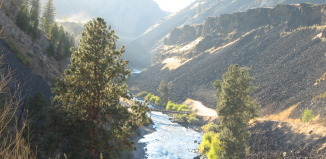A bird in the hand is good

From Greg Kaltenecker IBO — Special to the IOJ
LUCKY PEAK — Nearly 20 years ago, researchers from the Idaho Bird Observatory (IBO) discovered a world-class migration site in the Boise Foothills. Scientists discovered that during their autumn migration, birds concentrate briefly in the foothills before continuing south over the Snake River Plain.
The area turned out to be a perfect place to study migratory birds, monitor their populations and promote viewing and educational opportunities for the public. Because so many birds gather at the site annually it was voted an Important Bird Area by the National Audubon Society.
Today, the IBO, an academic research and public outreach program based at Boise State University, maintains a long-term monitoring study of bird migration in the Boise Foothills. A field station is located on Lucky Peak, the southernmost mountain on the Boise Ridge that overlooks Lucky Peak Reservoir and the Treasure Valley.
More than 125 species of songbirds and raptors (about 6,000 birds annually) have been captured and banded during standardized counts of their southern migration. It is a unique experience to visit and participate in this work that represents a perfect blend of science, nature and education that leaves a lasting impression on those who experience it. It is also a great way to introduce kids to the outdoors and fuel their interests in nature and animals.
As visitors young and old alike observe and participate in research and monitoring activities they handle warblers, tanagers, vireos, sparrows, juncos and others. Children are hooked when they get to hold and release these wild birds after banding. This hands-on education is one of the most powerful conservation tools allowing individuals to handle and release hawks, falcons and eagles.
Visitors are so taken with the activities that they come again and volunteer their time as most of the research and monitoring is conducted by volunteers.
The average volunteer is familiar with many of the migratory birds that are studied. Dozens of species of Western songbirds and raptors spend the winters in Mexico, Central America, and even as far south as South America. They return to the western United States in late April or May to breed, and by August or early September, many of these birds have already left.
That’s a big effort to fly so far to spend only a few short months in the temperate zone, but it is a strategy that has evolved over thousands of years to take advantage of the vast food resources available here during northern summers.
The IBO begins its operations on Lucky Peak starting in mid-July, when many species are already moving out. Songbird banding occurs daily from sunrise until about noon through mid-October. Later, at the end of August, the IBO begins a daily standardized hawk migration count and raptor banding through late-October.
The best time to visit is when you can, but the last two weeks of September represent the peak time for autumn bird migration in Idaho.
For more information, visit the IBO website at: http://www.idahobirdobservatory.org/index.html



